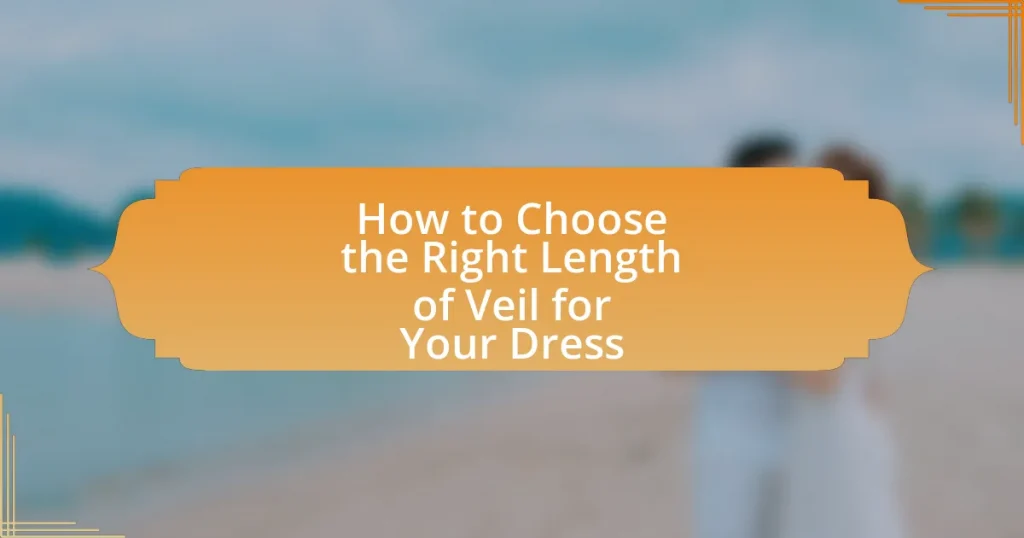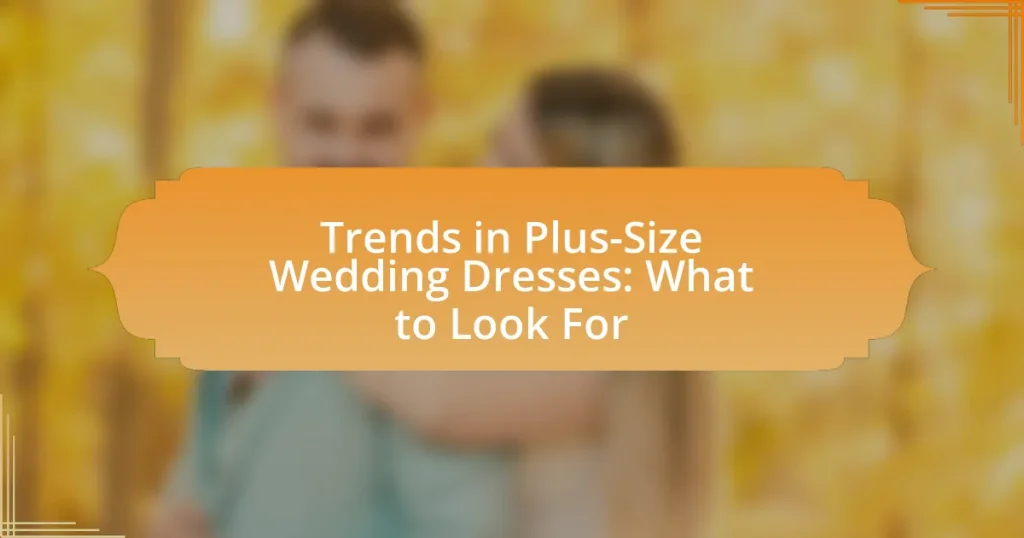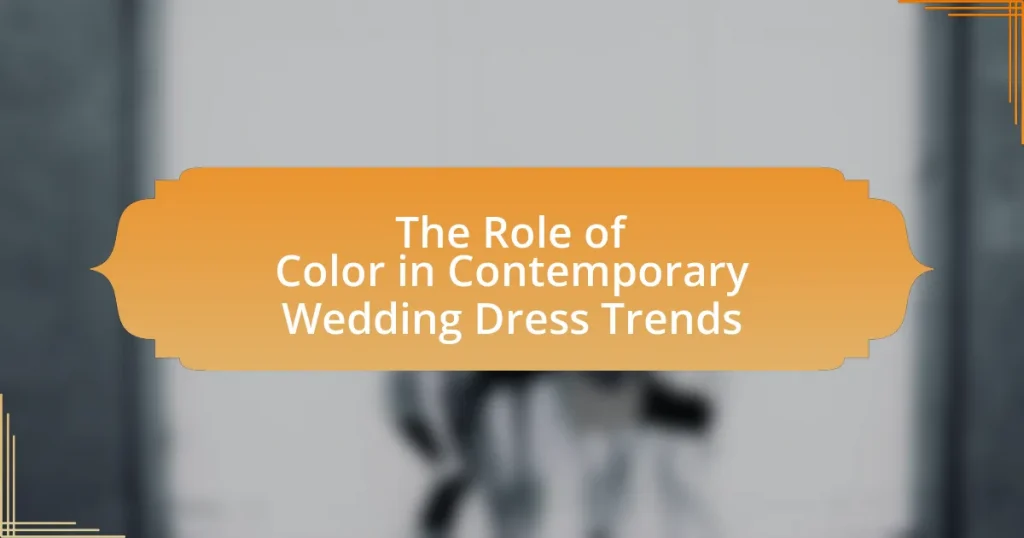The article focuses on how to choose the right length of veil for a wedding dress, emphasizing the importance of factors such as dress style, formality of the event, personal preferences, and height. It outlines the relationship between different dress silhouettes and veil lengths, detailing how neckline styles and wedding themes influence veil selection. Additionally, the article discusses various veil types, including birdcage, elbow, fingertip, chapel, and cathedral, while providing guidance on visualizing and finalizing the perfect veil length. Common mistakes to avoid and best practices for ensuring a harmonious bridal look are also highlighted.
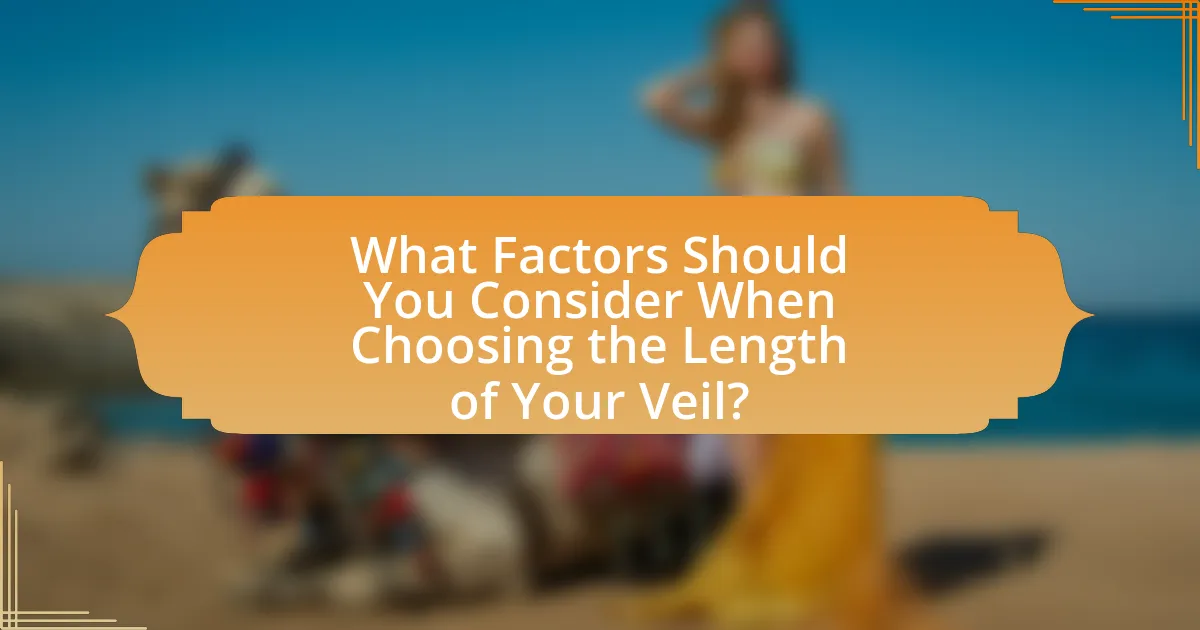
What Factors Should You Consider When Choosing the Length of Your Veil?
When choosing the length of your veil, consider the style of your wedding dress, the formality of the event, and your personal preferences. The style of the dress significantly influences veil length; for instance, a long train may pair well with a longer veil, while a simpler dress might suit a shorter veil. The formality of the wedding also plays a crucial role; more formal weddings often call for longer veils, while casual settings may be complemented by shorter options. Personal preferences, including comfort and desired aesthetic, should guide your choice as well, ensuring that the veil enhances your overall look.
How does the style of your dress influence veil length?
The style of a dress significantly influences veil length by determining the overall silhouette and aesthetic of the bridal look. For example, a fitted gown may pair well with a shorter veil to maintain a streamlined appearance, while a ball gown often complements a longer veil that adds drama and elegance. Additionally, intricate dress details, such as lace or embellishments, may necessitate a shorter veil to avoid overshadowing these features. This relationship between dress style and veil length is supported by bridal fashion guidelines, which suggest that the veil should enhance rather than compete with the dress design.
What dress silhouettes pair best with specific veil lengths?
A-line and ball gown silhouettes pair best with cathedral-length veils, as the volume of the dress complements the dramatic length of the veil. Sheath dresses work well with fingertip-length veils, providing a streamlined look that enhances the dress’s silhouette. Tea-length dresses are best matched with shoulder-length veils, creating a balanced appearance that maintains the dress’s playful style. Finally, mermaid silhouettes are ideally suited for chapel-length veils, as the fitted shape of the dress allows the veil to flow elegantly behind. These pairings are based on the visual harmony created between the dress and veil lengths, ensuring a cohesive bridal look.
How do neckline styles affect veil choice?
Neckline styles significantly influence veil choice by determining the appropriate length and style of the veil to complement the dress. For instance, a strapless or sweetheart neckline often pairs well with a longer veil that cascades down the back, enhancing the elegance of the exposed shoulders. Conversely, a high neckline or a halter style typically suits shorter veils, as longer options may overwhelm the silhouette. Additionally, intricate necklines with embellishments may require simpler veil designs to avoid clashing, ensuring a harmonious overall look. This relationship between neckline and veil choice is essential for achieving a balanced and aesthetically pleasing bridal ensemble.
What role does your wedding theme play in veil selection?
The wedding theme significantly influences veil selection by dictating the style, fabric, and embellishments that complement the overall aesthetic. For instance, a vintage-themed wedding may call for lace veils with intricate detailing, while a modern theme might favor sleek, minimalist designs. This alignment ensures that the veil enhances the bride’s look in harmony with the chosen theme, creating a cohesive visual experience throughout the ceremony.
How can a formal theme dictate veil length?
A formal theme can dictate veil length by establishing a specific aesthetic that aligns with the overall style of the event. For instance, traditional formal weddings often favor longer veils, such as cathedral or chapel lengths, which complement the grandeur of formal attire and settings. In contrast, a more modern or casual formal theme may allow for shorter veils, like birdcage or fingertip lengths, which can enhance a sleek and contemporary look. The choice of veil length is thus influenced by the formality of the wedding, ensuring that the veil harmonizes with the dress and the overall ambiance of the occasion.
What lengths are suitable for casual weddings?
Suitable lengths for casual weddings typically include shoulder-length, elbow-length, and fingertip-length veils. These lengths complement the relaxed atmosphere of casual weddings while still adding elegance. For instance, shoulder-length veils offer a playful touch, elbow-length veils provide a balance of sophistication and ease, and fingertip-length veils can enhance a casual dress without overwhelming it. Each of these lengths is appropriate for a variety of dress styles, making them versatile choices for brides seeking a laid-back yet stylish look.
Why is your height an important consideration for veil length?
Your height is an important consideration for veil length because it directly influences how the veil will complement your overall silhouette. Taller individuals may opt for longer veils to create a balanced look, while shorter individuals might choose shorter veils to avoid overwhelming their frame. For instance, a floor-length veil can enhance the elegance of a taller bride, while a shorter veil can provide a more proportionate appearance for someone of shorter stature. This consideration ensures that the veil enhances the dress and the bride’s figure, creating a harmonious visual effect.
How does height affect the visual impact of the veil?
Height significantly influences the visual impact of the veil by altering its proportions and how it frames the face and body. Taller individuals may opt for longer veils, which can create a dramatic effect and enhance the overall silhouette, while shorter individuals might choose shorter veils to avoid overwhelming their stature. Research indicates that the length of the veil should complement the wearer’s height to maintain balance; for instance, a study published in the Journal of Fashion Technology found that veils that are too long on shorter individuals can detract from their overall appearance, making them appear shorter. Thus, selecting a veil length that corresponds to one’s height is crucial for achieving a harmonious look.
What lengths are recommended for different heights?
For individuals of different heights, recommended veil lengths vary to achieve a balanced look. Generally, for heights of 5’0″ to 5’3″, a veil length of 54 inches is suggested; for those between 5’4″ and 5’6″, a length of 72 inches is ideal; and for heights of 5’7″ and above, a veil length of 90 inches or longer is recommended. These lengths ensure that the veil complements the dress and the overall silhouette, enhancing the bridal appearance.

What Are the Different Types of Veil Lengths Available?
The different types of veil lengths available include birdcage, elbow, fingertip, chapel, and cathedral. Birdcage veils are short, typically covering the face and extending to the chin. Elbow-length veils reach the elbows, providing a modest look. Fingertip veils extend to the fingertips, offering a balance between short and long styles. Chapel veils are longer, reaching the floor but not extending beyond it, while cathedral veils are the longest, trailing several feet behind the bride. Each length serves different aesthetic purposes and complements various dress styles, making it essential for brides to choose based on their gown and personal preference.
What are the standard veil lengths and their names?
The standard veil lengths and their names include the following:
- Birdcage Veil – typically 9 to 12 inches long.
- Blusher Veil – usually 20 to 30 inches long, covering the face.
- Elbow Veil – approximately 25 to 30 inches long, reaching the elbows.
- Fingertip Veil – around 30 to 36 inches long, reaching the fingertips.
- Chapel Veil – generally 90 to 108 inches long, extending to the floor.
- Cathedral Veil – typically 120 inches or longer, trailing behind the bride.
These lengths are commonly recognized in bridal fashion, providing options that complement various dress styles and wedding themes.
What defines a birdcage veil?
A birdcage veil is a short, netted veil that typically covers the face and is attached to a headpiece, such as a comb or a fascinator. This style of veil is characterized by its vintage aesthetic, often made from materials like tulle or lace, and it usually falls just below the eyes or above the chin. The birdcage veil gained popularity in the mid-20th century and is often associated with retro bridal looks, making it a unique choice for modern brides seeking a classic yet contemporary appearance.
How does a chapel veil differ from a cathedral veil?
A chapel veil is shorter than a cathedral veil, typically measuring around 90 to 108 inches in length, while a cathedral veil can extend up to 120 inches or more. The chapel veil is designed to fall just past the shoulders or to the waist, making it suitable for more casual or semi-formal weddings. In contrast, the cathedral veil, being longer, creates a dramatic effect and is often chosen for formal ceremonies, enhancing the bridal gown’s elegance. This distinction in length and style influences the overall aesthetic of the wedding attire, guiding brides in their selection based on the formality of their event.
How do you choose between short and long veils?
To choose between short and long veils, consider the overall style of your wedding dress and the formality of the event. Short veils, typically ending at the shoulders or elbows, complement simpler, less formal dresses and are easier to manage, making them ideal for casual weddings. Long veils, extending to the waist, floor, or even beyond, enhance more elaborate gowns and add a dramatic effect, suitable for formal ceremonies. The choice should align with your personal style and the wedding theme, ensuring harmony between the veil and the dress.
What are the advantages of short veils?
Short veils offer several advantages, including ease of movement, versatility, and a modern aesthetic. Their shorter length allows brides to move freely without the risk of tripping or getting caught on objects, making them ideal for outdoor or active ceremonies. Additionally, short veils can complement a variety of dress styles, from casual to formal, enhancing the overall look without overwhelming it. The contemporary appeal of short veils aligns with current bridal trends, making them a popular choice among modern brides.
What are the benefits of long veils?
Long veils offer several benefits, including enhanced elegance, dramatic effect, and versatility in styling. The length of a veil can create a striking visual impact, often complementing formal wedding attire and adding a sense of grandeur to the overall look. Additionally, long veils can be styled in various ways, such as cascading down the back or being worn over the face, allowing for creative expression and personalization. Historically, long veils have been associated with tradition and formality, making them a popular choice for brides seeking a classic aesthetic.
What unique styles can you consider for your veil length?
Unique styles for veil length include cathedral, chapel, fingertip, elbow, and birdcage veils. Cathedral veils are the longest, typically extending beyond the train of the gown, creating a dramatic effect. Chapel veils are slightly shorter, reaching the floor but not extending beyond the gown’s train. Fingertip veils fall to the fingertips, offering a balance between elegance and practicality. Elbow-length veils reach the elbow, providing a vintage look, while birdcage veils are short and often made of netting, adding a retro flair. Each style complements different dress silhouettes and personal aesthetics, allowing brides to express their individuality on their wedding day.
How can custom lengths enhance your bridal look?
Custom lengths can enhance your bridal look by providing a tailored fit that complements your dress and personal style. When a veil is designed to match the specific length of your gown, it creates a harmonious visual flow, accentuating your silhouette and enhancing the overall aesthetic. For instance, a cathedral-length veil can add drama and elegance to a ball gown, while a shorter veil may suit a more casual or fitted dress. This customization ensures that the veil not only matches the dress but also reflects the bride’s individuality, making the overall look more cohesive and personalized.
What are some trending veil styles in 2023?
Trending veil styles in 2023 include cathedral veils, birdcage veils, and lace-trimmed veils. Cathedral veils, known for their dramatic length, often extend beyond the train of the wedding dress, making them a popular choice for formal ceremonies. Birdcage veils, characterized by their short, vintage-inspired design, provide a chic and modern twist, often paired with retro hairstyles. Lace-trimmed veils continue to be favored for their romantic and elegant appeal, complementing various dress styles. These trends reflect a blend of traditional and contemporary aesthetics, catering to diverse bridal preferences.
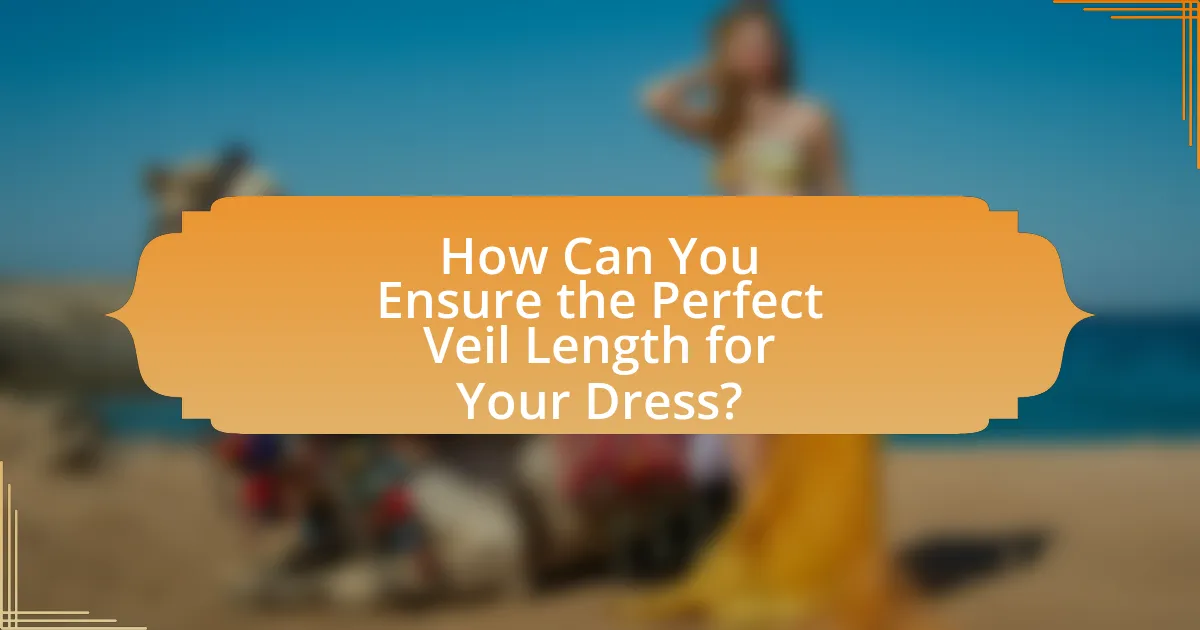
How Can You Ensure the Perfect Veil Length for Your Dress?
To ensure the perfect veil length for your dress, measure from the top of your head to the desired point on your body where you want the veil to fall, such as the waist or the floor. This measurement should consider the style of your dress; for example, a longer gown typically pairs well with a longer veil, while a shorter dress may look better with a shorter veil. Additionally, consider the overall silhouette and train of your dress, as these factors influence how the veil will complement your look.
What tips can help you visualize veil length with your dress?
To visualize veil length with your dress, use a measuring tape to determine the desired length from the top of your head to the floor or the hem of your dress. This method allows you to see how different lengths, such as fingertip, chapel, or cathedral, will complement your gown. Additionally, try on a similar veil style in a bridal shop to get a real-time sense of how the veil interacts with your dress. This practical approach helps in making an informed decision about the veil length that best suits your overall look.
How can you use a fitting to determine the best length?
To determine the best length of a veil, conduct a fitting where the veil is tried on with the dress. During the fitting, assess how the veil complements the dress’s silhouette and overall style. Observing the veil’s interaction with the dress allows for adjustments based on personal preference and visual appeal, ensuring the chosen length enhances the overall look.
What role does accessorizing play in veil length choice?
Accessorizing significantly influences veil length choice by complementing the overall bridal look and enhancing the dress’s design. For instance, a long veil may be chosen to match a heavily embellished gown, creating a cohesive aesthetic, while a shorter veil can highlight intricate details of a simpler dress. Additionally, accessories like tiaras or hairpins can dictate veil length; a more elaborate headpiece may require a shorter veil to avoid overwhelming the overall appearance. This relationship between accessories and veil length is supported by bridal fashion trends, which often emphasize harmony between all elements of the bridal ensemble.
What common mistakes should you avoid when selecting veil length?
When selecting veil length, avoid choosing a length that does not complement your dress style. A common mistake is selecting a veil that is too long or too short for the gown, which can disrupt the overall silhouette. For instance, a floor-length gown typically pairs well with a cathedral veil, while a tea-length dress is better suited for a shorter veil. Additionally, neglecting to consider your height can lead to mismatched proportions; taller brides may need longer veils to maintain balance, while shorter brides might opt for shorter styles to avoid overwhelming their frame. Lastly, failing to account for the venue can also be a mistake; a long veil may be impractical for a casual outdoor wedding, while a more formal setting may call for an elaborate design.
How can you prevent mismatching your veil with your dress?
To prevent mismatching your veil with your dress, ensure that both items share a similar color palette and fabric type. Selecting a veil that complements the dress’s color, whether it’s a matching shade or a harmonious contrast, is crucial. For instance, if the dress is ivory, choosing an ivory veil will maintain visual consistency. Additionally, matching the fabric type, such as lace or tulle, enhances cohesion in the overall look. This approach is supported by bridal fashion experts who emphasize the importance of color and texture alignment in achieving a unified bridal appearance.
What are the pitfalls of choosing a veil length without trying it on?
Choosing a veil length without trying it on can lead to mismatches in style, proportion, and comfort. Without a fitting, the bride may select a length that does not complement her dress or body shape, resulting in an unbalanced appearance. Additionally, the veil’s weight and drape can vary significantly based on fabric and length, which may cause discomfort or restrict movement if not tested. Studies in fashion design emphasize the importance of fit and proportion, indicating that visual harmony is crucial for overall aesthetic appeal. Therefore, trying on the veil ensures that it aligns with the bride’s vision and enhances her overall look.
What are the best practices for finalizing your veil length decision?
To finalize your veil length decision, consider your dress style, venue, and personal comfort. The dress style significantly influences veil length; for instance, a long train may pair well with a longer veil, while a simpler dress might suit a shorter veil. The venue also plays a role; outdoor settings may require a more practical length to avoid entanglement, while formal indoor venues can accommodate longer veils. Additionally, personal comfort is crucial; ensure that the chosen length allows for ease of movement and does not obstruct your vision. These factors collectively guide you in making an informed decision about veil length.
